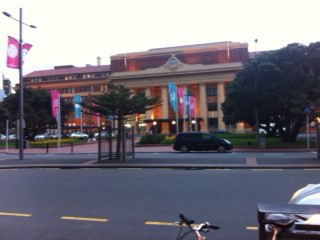
Britomart in Auckland changed everything, and Len Brown was able to persuade John Key that rail was the urban transport future for main routes. Chris Laidlaw should do the same for Wellington to get NZTA funding for RLR to Kilbirnie and the airport.

Classy Rapid Light Rail appeals to everyone including business.
In 1993 we raised $27K (today $43K) from CBD offices to promote it. Market research overseas shows people are prepared to pay double the fare for the same trip. Trams are like quality cars. The image and status gives people the ‘feel-good’ factor, which is the transport planning key.
The Airport Flyer is not subsidised, giving clear evidence people pay for quality.

First stop Clarries between Queens Wharf and the Cable Car, second the back of the Civic Square to Chews Lane, third either the back of Reading close to Te Papa then to the Embassy, or up Taranaki to Courtenay and Massey.

A good but slower option is to start on the forecourt at the entrance to the station like Central Station Sydney does for its new trams. Then down Stout St to Lambton Quay, Willis St and Courtenay Place.

Three-quarters of our region’s population lives north of the railway station. About 11 million trips per year are made by rail to and from the station. Most of these are people walking to the CBD. The RLR would attract folk who travel by car into the distant parts of the CBD because they can’t be bothered with buses.
Basin Reserve: When the system is extended to the hospital, or eventually to the airport via the Zoo-Kilbirnie tunnel or Constable St, the traffic congestion around the Basin would dramatically reduce. Airport patronage is forecast to double from 5 to 10 million trips in 2030. The airport is an anchor with an exotic and highly marketable image for visitors. As a strategic transport link to the airport, RLR will warrant national funding.
Costs: Official UK Department of Transport figures place the infrastructure cost at $105 million for the three kilometre first stage to the Embassy or Massey. Three pairs of leased trams would provide a 10 minute shuttle service. The 3 km first stage of the project would be designed to achieve an economic benefit-cost ratio of 1.3 which would justify most of the capital costs to be funded by central government.
Daryl Cockburn (Architect:Planner) & Dr Neil Douglas (Economist) 14.09.2016

Leave a Reply